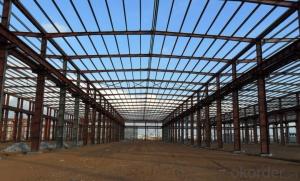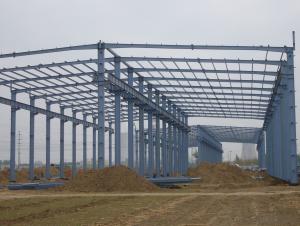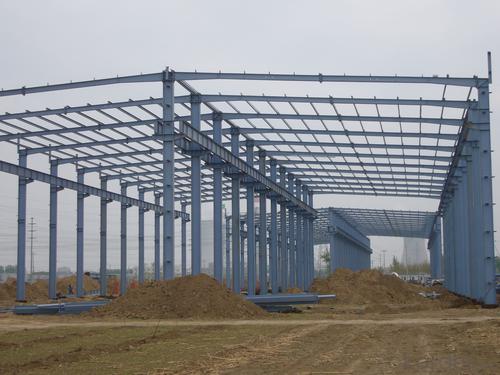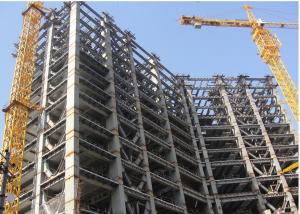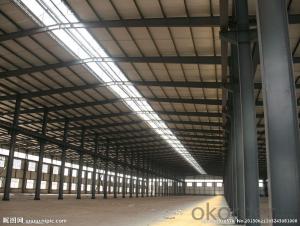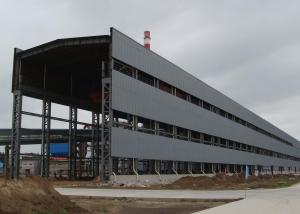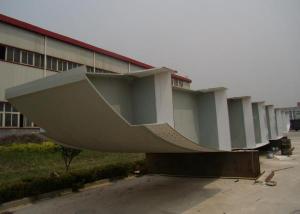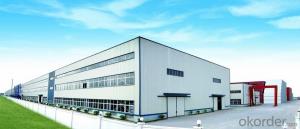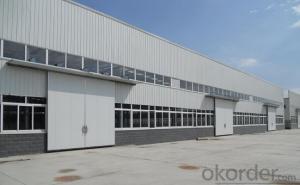Large-Span Pre Engineering Steel Structure Building
- Loading Port:
- China Main Port
- Payment Terms:
- TT OR LC
- Min Order Qty:
- -
- Supply Capability:
- -
OKorder Service Pledge
OKorder Financial Service
You Might Also Like
Specifications
Specifications
1) . Easy to install, fire proof, good insulation
2). Certification: ISO9001:2000, SGS Standard.
Steel Structure Warehouse:
1.The steel structure of the connection method: welding connection
2.Steel structure design common norms are as follows: "Steel Design Code" (GB50017-2003) Cold-formed steel structure technical specifications" (GB50018-2002) "Construction Quality Acceptance of Steel" (GB50205-2001) "Technical Specification for welded steel structure" (JGJ81-2002, J218-2002) "Technical Specification for Steel Structures of Tall Buildings" (JGJ99-98)
3.The characteristics of steel Light weight steel structure Higher reliability of steel work Steel anti-vibration (earthquake), impact and good Steel structure for a higher degree of industrialization Steel can be assembled quickly and accurately Large steel interior space Likely to cause sealing structure Steel corrosive Poor fire-resistant steel Recyclable steel shorter duration
4.Commonly used steel grades and performance of steel Carbon
structural steel: Q195, Q215, Q235, Q255, Q275, etc.
High-strength low-alloy structural steel Quality carbon structural steel and alloy structural steel Special purpose steel Product Feature Carport, House, Office, Shop, Toilet, Villa, Warehouse, Workshop, Plant Other Information
Products have been all over the country more than 20 provinces, municipalities and autonomous regions, and have been exported to Europe, North America, the Middle East, Africa, Asia and other countries and regions, the widespread use
Welcome to our factory, we assure that our products will satisfy your needs with designs, competitive performance price ratio and best services.
- Q: How do steel structures perform in terms of resistance to electromagnetic interference?
- Steel structures generally provide a high level of resistance to electromagnetic interference. Due to their conductive properties, steel can effectively shield against external electromagnetic fields, minimizing the impact on sensitive electronic devices or communication systems within the structure. However, the effectiveness of the shielding can vary depending on the thickness, configuration, and quality of the steel used.
- Q: What are the considerations for designing steel structures for marine environments?
- When designing steel structures for marine environments, several important considerations need to be taken into account. First, corrosion prevention is crucial as exposure to saltwater and moisture can accelerate the deterioration of steel. Therefore, selecting corrosion-resistant steel grades, coatings, and protective measures such as sacrificial anodes or cathodic protection systems is essential for the longevity of the structure. Additionally, the design should incorporate measures to withstand the dynamic loads imposed by waves, currents, and wind. Steel structures in marine environments are subject to harsh weather conditions, so they must be designed to withstand extreme forces, including hydrostatic pressure, wave impact, and wind loads. Structural fatigue is another consideration, as the constant cyclic loading from waves can lead to accumulative damage over time. Proper detailing, stress analysis, and material selection are therefore necessary to ensure the structure's fatigue resistance and durability. Lastly, the design should accommodate potential movements and deformations caused by tidal fluctuations, temperature changes, and settlement. Flexibility and adaptability must be incorporated to allow for these movements without compromising the overall integrity of the structure. Overall, designing steel structures for marine environments requires careful attention to corrosion prevention, dynamic load resistance, fatigue resistance, and accommodation of movements, ensuring a safe and durable structure in the challenging marine environment.
- Q: How do steel structures provide efficient use of space?
- Efficient utilization of space is a primary advantage of steel structures, owing to their strength and durability. Steel is renowned for its high strength-to-weight ratio, enabling it to support heavy loads while minimizing material requirements. Consequently, large and tall structures can be constructed without the need for excessive space. Furthermore, steel structures can be designed with extended spans, necessitating fewer columns or supports. This results in open and flexible floor plans, facilitating efficient space utilization. Additionally, steel enables the creation of vast clear spans, eliminating obstructions within the structure and maximizing usable area. Moreover, steel structures can be prefabricated off-site and subsequently assembled on-site. This reduces construction time and minimizes disruption to the surrounding environment. The capacity for prefabricating steel components also ensures precise and accurate construction, guaranteeing effective utilization of every inch of space. Lastly, steel structures possess the advantage of easy modification or expansion. The flexibility of steel allows for seamless integration of additional floors or extensions, accommodating changing needs or requirements. This adaptability ensures efficient long-term space utilization. In conclusion, steel structures offer efficient space utilization through their strength, durability, capacity for extended and clear spans, prefabrication capabilities, and flexibility for future modifications.
- Q: How are steel structures used in industrial applications?
- Steel structures are extensively used in industrial applications due to their strength, durability, and versatility. They are commonly employed in the construction of factories, warehouses, power plants, and other industrial facilities. Steel frames provide excellent support for heavy machinery and equipment while ensuring safety and stability. Additionally, steel structures can be easily customized and modified to accommodate various production needs, making them a preferred choice in industrial settings.
- Q: What are the common defects found in steel structures?
- Some common defects found in steel structures include corrosion, fatigue cracks, weld defects, distortion, and inadequate design or construction.
- Q: How are steel structures used in transportation infrastructure?
- Steel structures are commonly used in transportation infrastructure due to their strength, durability, and versatility. They are used in the construction of bridges, tunnels, railway tracks, and airport terminals, among others. Steel's high load-bearing capacity allows for the construction of large and long-span structures, ensuring the safety and efficiency of transportation systems. Additionally, steel structures can be prefabricated, enabling faster construction and reducing disruption to traffic flow during infrastructure projects.
- Q: How are steel structures designed for efficient use of space and urban density?
- Steel structures are designed with careful consideration for efficient use of space and urban density. The inherent properties of steel, such as its high strength-to-weight ratio and versatility, make it an ideal material for creating structures that maximize space utilization. One way steel structures achieve efficient use of space is through their ability to support large spans. Steel beams and columns can span long distances without the need for intermediate support, allowing for open floor plans and flexible layouts. This is particularly advantageous in urban areas where land is scarce and expensive. By eliminating the need for numerous vertical supports, steel structures can create larger usable spaces, maximizing the available square footage. Additionally, steel structures can be designed to have slender and lightweight components, minimizing the amount of space occupied by the structure itself. This is especially crucial in densely populated urban areas where every square meter is valuable. The lightweight nature of steel allows for thinner floor systems, reducing the overall height of the building and maximizing the number of floors that can be constructed within a given space. Furthermore, steel structures can be easily expanded or modified, allowing for adaptability to changing needs and requirements. This flexibility is essential in urban environments where space utilization may need to be adjusted over time. Steel's modular nature enables the addition or removal of components without compromising the integrity of the structure, making it easier to accommodate future expansions or renovations without significant disruption. Lastly, steel structures can be designed to be aesthetically pleasing and visually appealing, contributing to the overall urban landscape. The use of steel in innovative architectural designs allows for the creation of iconic structures that define the urban skyline. These visually striking buildings can attract businesses, residents, and tourists, further enhancing the urban density and economic growth of an area. In conclusion, steel structures are designed to optimize space utilization and accommodate urban density. Through their ability to support large spans, minimize space occupied by the structure, provide flexibility for future modifications, and contribute to the aesthetic appeal of the urban landscape, steel structures play a crucial role in efficient urban development.
- Q: How can steel structures be divided into general steel structures, large steel structures and other steel structures?
- Specification for design of steel structure GB50017-2003 is not defined, only in 8.6.1 said a cross over 60m calculation of large span steel roof. In civil engineering, general light plant "steel structure", "medium factories steel structure, heavy plant" steel structure "and" other steel structure ";" according to the structure type of frame structure, frame structure, frame structure, frame structure, "" other structures".
- Q: How are steel structures used in the construction of pharmaceutical plants?
- The benefits and advantages of steel structures make them widely used in the construction of pharmaceutical plants. Steel is a strong and durable material that can withstand heavy loads and extreme weather conditions, making it perfect for supporting complex equipment and machinery. Additionally, steel is highly versatile and can be easily molded and shaped to create unique architectural designs that meet the specific needs of pharmaceutical facilities. This versatility also allows for the integration of additional features, such as mezzanine floors and storage platforms, optimizing space within the plant. Furthermore, steel structures offer excellent fire resistance properties, providing an added layer of safety in pharmaceutical facilities where hazardous materials are handled and stored. Steel does not burn, melt, or emit toxic fumes, making it a safe choice in case of fire emergencies. The speed and ease of assembly is another advantage of using steel structures in pharmaceutical plant construction. Pre-engineered steel components can be fabricated off-site, reducing construction time and minimizing disruption to plant operations. The precise manufacturing and quality control processes associated with steel fabrication ensure a faster and more efficient construction process. Moreover, steel is a sustainable and environmentally friendly choice. It is a recyclable material, allowing for the reuse of steel components in future projects, reducing waste and minimizing the environmental impact. Steel structures also contribute to green building certifications and energy efficiency by allowing for the incorporation of insulation and other energy-saving features, reducing the overall energy consumption of the pharmaceutical plant. In conclusion, steel structures provide strength, durability, versatility, fire resistance, ease of assembly, and sustainability in the construction of pharmaceutical plants. These qualities make steel an ideal choice for supporting complex equipment, ensuring safety, optimizing space, and facilitating efficient construction processes in pharmaceutical facilities.
- Q: What is the role of steel in communication and data networks?
- Steel plays a crucial role in communication and data networks, although it might not be immediately apparent. In the construction of communication towers, which are essential for transmitting signals over long distances, steel is the primary material used. The strength, durability, and stability of steel make it an ideal choice for these tall structures. Communication towers are responsible for supporting antennas, satellite dishes, and other equipment that facilitate wireless communication and data transmission. Steel's structural integrity allows these towers to withstand extreme weather conditions, such as high winds and heavy snowfall, ensuring uninterrupted communication services. Moreover, steel is used extensively in the manufacturing of data center infrastructure. Data centers house the servers and networking equipment that store and process vast amounts of digital information. Steel racks and cabinets provide a sturdy framework for organizing and supporting these sensitive components, ensuring the efficient and secure operation of data networks. Steel is also present in the underground infrastructure of communication networks. Telecommunication cables, including fiber optic cables, are often encased in steel conduits or trays for protection. These steel enclosures shield the cables from external damage, such as impact or extreme temperatures, ensuring reliable data transmission. In addition to its structural and protective roles, steel is crucial for grounding and bonding systems in communication and data networks. Grounding is essential to protect equipment and personnel from electrical surges and to maintain proper signal quality. Steel rods and conductors are commonly used to establish a reliable electrical connection to the earth, dissipating excess electrical charges and maintaining system integrity. Overall, steel's strength, durability, and electrical properties make it an indispensable material in communication and data networks. From communication towers to data center infrastructure and underground enclosures, steel plays a vital role in ensuring the reliability, stability, and efficiency of modern communication and data transmission systems.
Send your message to us
Large-Span Pre Engineering Steel Structure Building
- Loading Port:
- China Main Port
- Payment Terms:
- TT OR LC
- Min Order Qty:
- -
- Supply Capability:
- -
OKorder Service Pledge
OKorder Financial Service
Similar products
Hot products
Hot Searches
Related keywords
